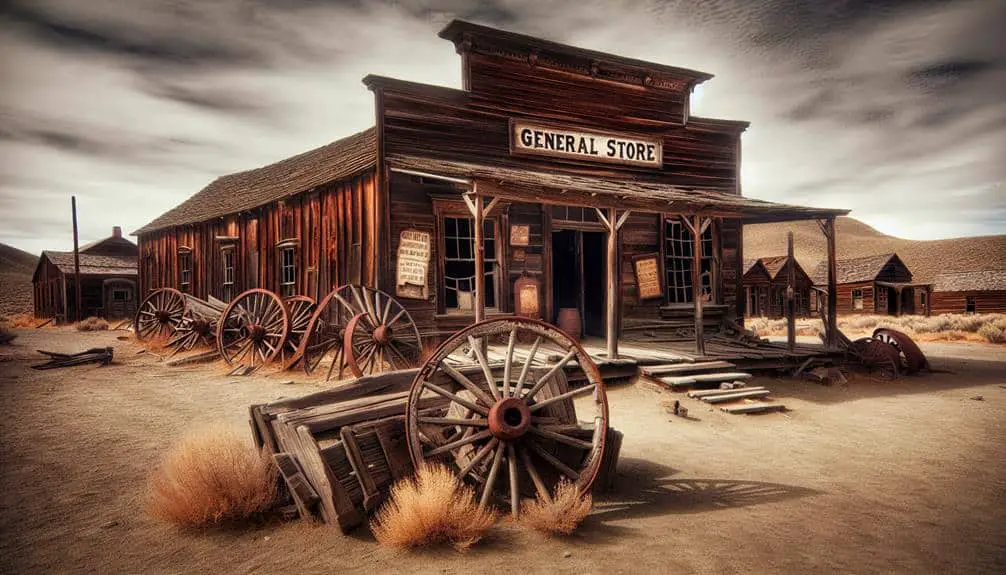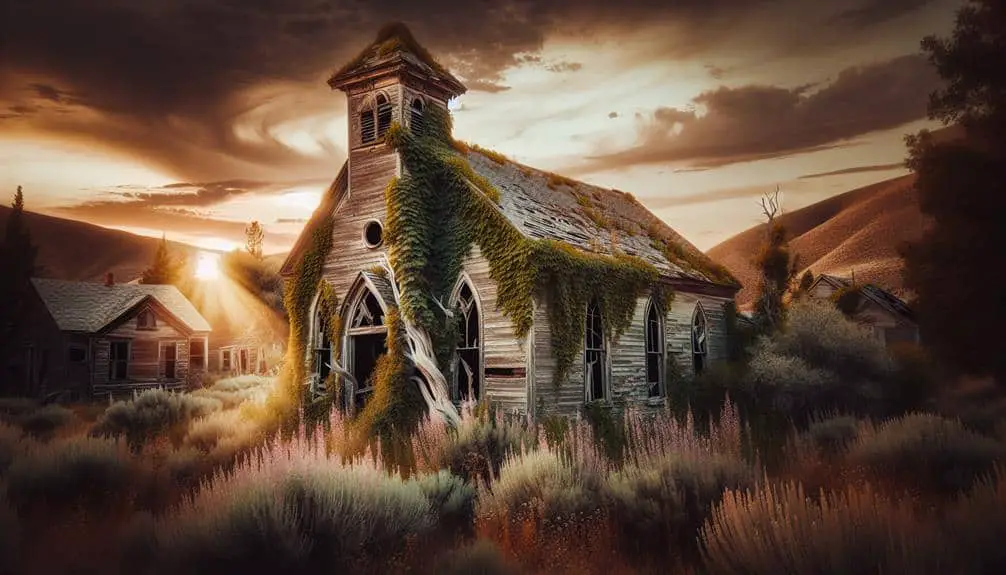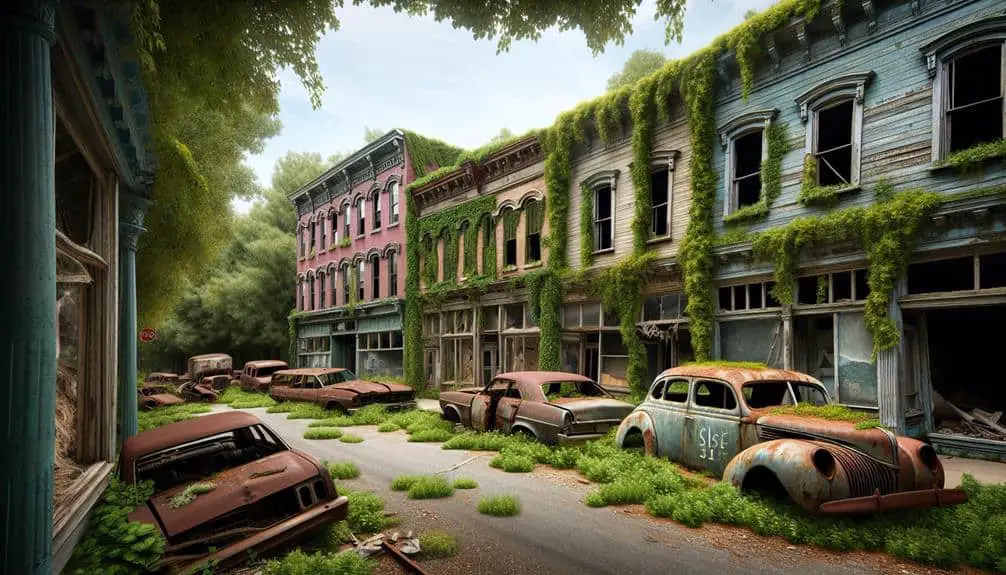US ghost town ruins feel compelling due to a blend of historical significance, natural decay, cultural influence, unique architecture, and the relentless march of time. These elements create a fascinating glimpse into the past that lingers in the atmosphere of these abandoned places. Each crumbling wall and weathered detail tells stories of eras long gone, waiting for you to uncover their secrets. The intricate web of factors that contribute to their authenticity makes each visit a journey back in time that you won't soon forget. There's a wealth of insights and wonders waiting to be discovered in these ancient ruins.
Key Points
- Natural preservation processes maintain authenticity.
- Architectural features reflect historical craftsmanship.
- Cultural influences shape the unique atmosphere.
- Time-induced decay adds to the ruins' realism.
- Erosion effects contribute to the authentic appearance.
Historical Significance of US Ghost Towns
The historical significance of US ghost towns lies in their ability to preserve a tangible connection to the past through the remnants of once-thriving communities. These towns, with their origins rooted in various catalysts such as mining booms, railroad construction, or economic downturns, offer a unique window into the past. Understanding the community dynamics of these abandoned sites is essential to appreciating their historical value.
Community dynamics in ghost towns were shaped by a multitude of factors, including the primary industries that sustained them, the socio-economic backgrounds of their residents, and the geographical challenges they faced. The interactions between individuals, families, and businesses within these towns provide insights into the social fabric of bygone eras.
Natural Preservation of Abandoned Sites
Naturally occurring processes play a significant role in the preservation of abandoned sites, contributing to their authentic representation of the past.
The decay process is an important factor in the natural preservation of ghost towns, as structures slowly crumble and return to the earth over time. Environmental factors such as weather patterns, humidity levels, and vegetation growth also play a pivotal role in the preservation of these sites, influencing the rate at which decay occurs and the overall appearance of the ruins.
Additionally, the presence of wildlife in abandoned areas can contribute to the preservation of these sites by inadvertently protecting them from human interference.
Cultural Influence on Ghost Town Authenticity
Cultural influences on the authenticity of ghost towns emerge through the societal remnants left behind in these abandoned sites. The cultural heritage embedded in these ghost towns plays a significant role in shaping their authenticity. From old saloons and churches to remnants of mining operations, these sites provide a glimpse into the past, reflecting the lifestyles and values of the communities that once thrived there. The preservation of cultural elements within ghost towns not only adds historical value but also enhances their tourism appeal.
The authenticity of ghost towns is often closely tied to their cultural significance. Visitors are drawn to these sites not just for their abandoned buildings but also for the stories they tell about the people who lived there. The cultural heritage preserved within these ghost towns creates a unique atmosphere that captures the imagination of tourists seeking a deeper connection to the past. By maintaining these cultural artifacts, ghost towns can continue to attract visitors and serve as valuable historical landmarks.
Architectural Features of Abandoned Buildings
Numerous architectural features found in abandoned buildings contribute substantially to the overall allure and historical richness of ghost towns. These structures, often affected by structural decay, hold hidden treasures waiting to be discovered by intrepid explorers like yourself. Here are three key architectural elements that enhance the authenticity of ghost town ruins:
- Facades and Ornate Details: The intricate facades and ornate details of abandoned buildings provide a glimpse into the past, showcasing the craftsmanship and architectural styles of a bygone era. These features speak volumes about the cultural and historical significance of the structures, making them intriguing to investigate.
- Weathered Materials and Textures: The weathered materials, such as rusted metal, weathered wood, and peeling paint, add a sense of authenticity to the abandoned buildings. These textures tell a story of the passage of time and the effects of nature on man-made structures, creating a fascinating visual narrative.
- Unique Architectural Designs: Many abandoned buildings boast unique architectural designs that reflect the cultural influences and architectural trends of their time. From Victorian-era mansions to industrial warehouses, each structure tells a tale of its past, inviting you to unravel the mysteries hidden within its walls.
Impact of Time on Ghost Town Ruins
The relentless passage of time inexorably alters the physical landscape of ghost town ruins, leaving behind poignant evidence of the ephemeral nature of human endeavors. Erosion effects play a significant role in the decay process of these abandoned structures. Over time, wind, rain, and extreme temperatures wear down the once sturdy walls and roofs, creating a sense of desolation and loss.
As the years go by, the external facade of the buildings starts to crumble, revealing the inner decay that has been silently progressing. Wooden structures warp and rot, metal elements rust and corrode, while paint fades and peels, all contributing to the gradual deterioration of the ghost town ruins.
Nature also plays a part in reclaiming these abandoned spaces, with vegetation slowly taking root in the crevices and cracks of the buildings. This intertwining of man-made structures and natural elements further highlights the impact of time on ghost town ruins, showcasing the relentless march of decay and transformation.
Frequently Asked Questions
How Do Ghost Town Ruins in the US Compare to Those in Other Countries?
When comparing ghost town ruins in the US to those in other countries, you'll notice unique architectural styles and historical contexts that reflect cultural significance. Global comparisons reveal varied authenticity and charm in each location.
Are There Any Famous Ghost Towns in the US That Have Been Completely Restored?
You might be surprised to discover that some famous US ghost towns have been completely restored through dedicated restoration projects and preservation efforts. These initiatives aim to preserve their cultural significance and historical accuracy.
What Role Do Local Governments Play in Preserving and Maintaining Ghost Town Ruins?
Local governments play an important role in preserving and maintaining ghost town ruins. Through local involvement, preservation efforts are funded, managed, and regulated to make sure these historical sites are protected for future generations to appreciate.
Are There Any Efforts to Incorporate Ghost Town Ruins Into Tourism or Educational Programs?
You'll find that conservation efforts are on the rise, with sustainability practices being key. Incorporating ghost town ruins into tourism and educational programs has a significant economic impact and fosters community engagement.
How Do Ghost Town Ruins in the US Contribute to Our Understanding of American History and Heritage?
Exploring ghost town ruins in the US allows you to investigate the historical significance and cultural heritage of American history. These sites offer insight into architectural preservation and have a profound impact on tourism.



